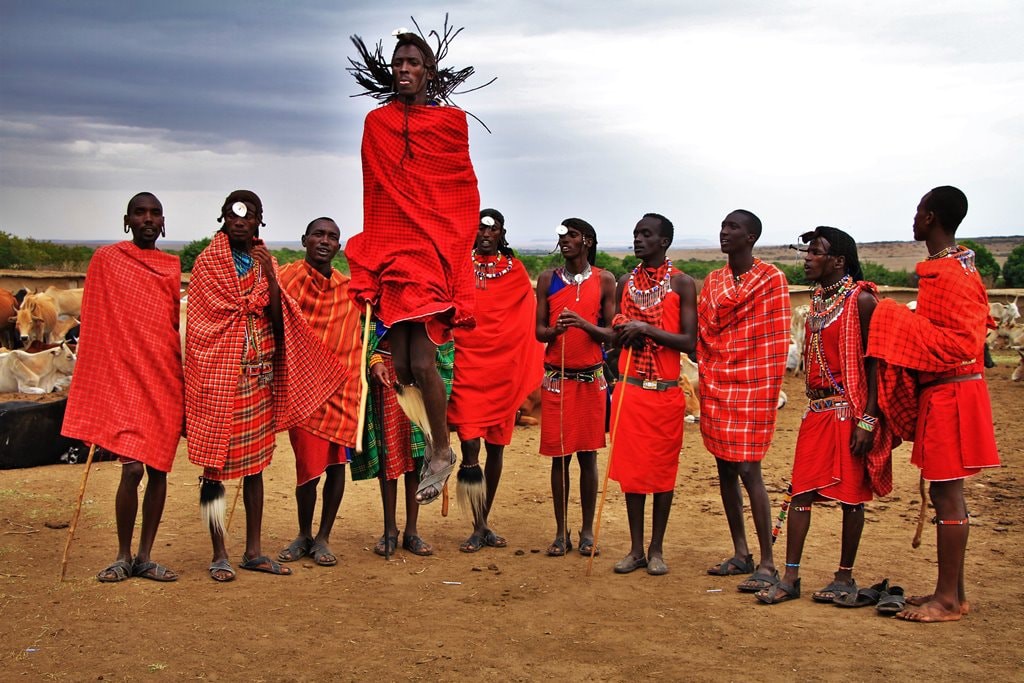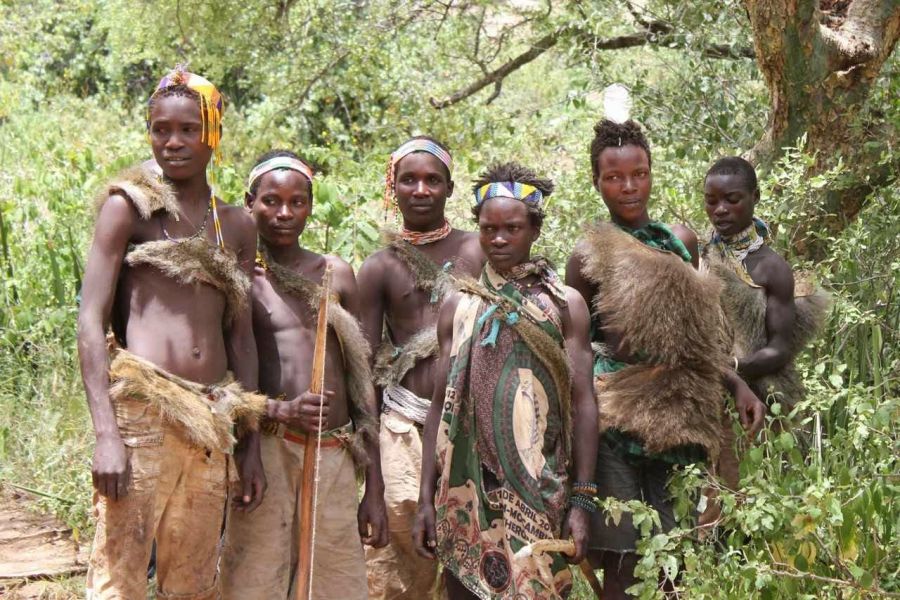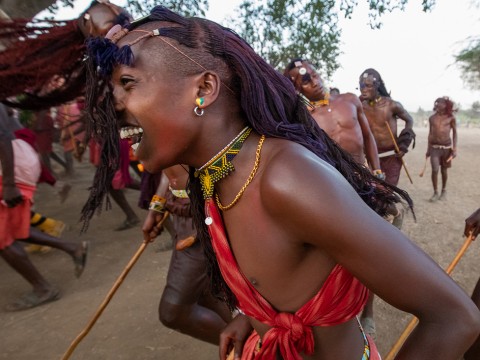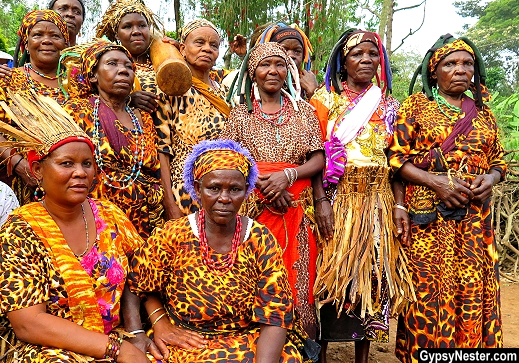TANZANIA TRIBES
Tanzania Tribes : Tanzania has more than 120 tribes and each practices their own culture, Get a chance to enjoy by staying with them at their communities, you will be able to learn and understand their way of living through sharing and participating with local in different activities like dances, and local food to thrill while Tanzania Tours

Hadzabe Tribe
They are located in north-central Tanzania, around Lake Eyasi in the central rift valley and adjacent plateaus of Serengeti National Park. They are known for their unique way of communicating by clicking sounds, which are unrelated to any regional language.
The Hadzabe are a small hunter-gatherer tribe, one of the world’s last remaining of its kind. Without livestock or agriculture, most mornings start with hunting and foraging. Gender roles are distributed where men typically hunt on their own to bring home meat and honey, while women and children gather fruits, berries, and roots.
The impact of tourism and pastoralist encroachment has for many years posed a severe threat to the continuation of their traditional way of life thus Tanzania Tribes.
History
The oral history of the Hadzabe tribes’ past is divided into four epochs, with each epoch inhabited by a different culture. The archaeological and genetic history of the Hadzabe reveals that they are not closely related to any other tribe. Although their language was once classified with the Khoisan languages because it has clicks, there is relatively little evidence that they are related.
The Hadzabe tribe became part of German East Africa but soon came under British control at the end of the First World War. Several attempts were also made by the British and the Tanzanian government to make the Hadzabe settle and adopt farming, but all their attempts failed as the Hadzabe people only settled to take advantage of the food provided, but leave and go back to foraging when the supply of food runs out.

CULTURE
The Hadzabe are semi-nomadic hunter-gatherers that are culturally and linguistically members of the Khoi (Person) and San (Foragers) groups. They have close affinities with the Sandiwe people, who possess cultural connections with the Khoekhoe hunter-gatherer communities of Southern Africa.
The Hadzabe women are adorned with “Hangweda” made of local pieces of skin, while the Hadzabe men are polygamists with a patriarchal social system.
DATOGA TRIBE
Known as the Mang’ati in Swahili, the Datoga people are known as an agro-pastoral nomadic Nilotic-speaking tribe, residing in the Manyara and Singida regions of north-central Tanzania near Mt. Hanang, Lake Basotu and Lake Eyasi. With well over 10 subtribes, its best subtribe is the pastoral Barabaig, who also reside mainly in the northern volcanic highlands encompassed by Mt. Hanang, which is a sacred mountain to the Barabaig.
History
Their migratory history has been somewhat reconstructed through the study of comparative linguistics and the oral tradition of the Datoga and its neighbors. They are said to be from South Sudan or the Western Ethiopian highlands. As their ancestors gradually migrated southward, this resulted in settlements in the highland areas of Kenya and Tanzania by speakers of Nilotic languages, herding, and farming in the rich highlands by about 1500 AD.
What are they known for
The Datoga tribe considers themselves the oldest tribe in Tanzania (other tribes like the Maasai and the Bushmen also claim this fame). They are typically known for keeping to themselves and are a tribe of proud people and fierce warriors known for their stealth ability. They are skillful and are also known for their blacksmith skills, beadwork, brass bracelets, and necklaces, while also supplying arrowheads to the Hadzabe tribe. Though they are known to herd goats, donkeys, sheep, and raise chickens, cattle are their most important domestic animals.
CULTURE
The Datoga’s, through the color of their outfits, blend in with their environment with a reddish brown colored soil outfit, reddish patched leather dresses, beadwork, bracelets, and necklaces. Another cultural identity and feature of theirs that distinguishes them from other tribes is their decorative tattooing around their eyes in circular patterns.
SONJO TRIBE
The Sonjo people are Bantu people, and their primary way of life is based solely on herding and agriculture. They are known to use traditional irrigation systems when farming. The Sonjo tribe is located in northern Tanzania, in the Ngorongoro district, about 30-40 miles west of Lake Natron thus Tanzania Tribes.
History
The Sonjo people are said to have lived in northern Tanzania for centuries, secluded within the Maasai territory. They are believed to have migrated to East Africa 400 years ago from Central Africa.
What they are known for
The Sonjo tribe is known for their agricultural way of life, which was believed to be the major reason their migration took place little by little over thousands of years in search of fertile and well-watered land to cultivate their crops.

CULTURE
Music plays a vital role in the Sonjo culture. Music shapes their entire way of life and is widely practiced in the entire community. It is used for several ritual purposes, such as rainmaking ceremonies, healing ceremonies, marriages, and other festive or civil events.
MAASAI TRIBE
They are located in North-Central Tanzania and Southern Kenya (you will likely interact with Maasai around the major national parks, such as Serengeti, Ngorongoro, etc.). Their language is known as Maa (Nilotic), while most of them speak Swahili or some English.
The Maasai tribe is internationally known and is among the most popular ethnic groups due to their distinct traditions, clothing, and close residence to the many national parks in East Africa. They are mainly pastoralist herders, with cattle being the primary economic driver of exchange. The Maasai are patriarchal and monotheistic, and their traditional diet derives almost exclusively from cattle-meat, milk, and blood.
The Maasai believe in one God, called “Engai,” though it has two natures: kind and vengeful. They have a “Laibon,” who is their spiritual leader. However, he doesn’t have any higher position in their community, just prophetic or healing powers.
History
According to oral history, they originated north of Lake Turkana (north-west of Kenya) in the lower Nile valley. In the 15th century, they began migrating south and arrived along a land stretching across Tanzania and Kenya’s borders, covering the Great Rift Valley and adjacent lands from Dodoma and Mt. Marsabit.
What they are known for
The Maasai tribe are known for their brightly colored outfits and traditional lifestyle focused on cattle, which make up the primary source of food. The wealth of a man is measured in terms of children and cattle, but he is also considered poor if he has many cattle but no children. Though they used spears and shields, they were most feared for their ability to expertly throw the orinka (club) from up to 70 paces (approximately 100 meters).
CULTURE
Firmly patriarchal in nature, most major disputes and matters are sometimes resolved or determined by retired elders and older Maasai men. They are monolithic in nature and believe in a god called Enkai or Engai. Maasai music traditionally consists of rhythms rendered by a chorus of harmonies sung by vocalists while the olaranyani (song leader) sings the melody.
CHAGGA TRIBE
As Tanzania’s third largest ethnic tribal group, the Chagga tribe resides on the southern slopes of Mount Kilimanjaro, which has two peaks, namely Kibo and Mawenzi. Most Chagga members are farmers (millet, bananas, coffee, etc.), and many also now practice Christianity and Islam. The Chagga are known for their strong work ethic, so if you decide to climb Kilimanjaro, chances are you will encounter members of the Chagga on your approach or as porters and guides thus Tanzania Tribes.
History
The Chagga tribe was divided into small autonomous chiefdoms traditionally belonging to different clans ruled by Mangi (chiefs). The system of chiefdoms was practiced until it was abolished throughout the country after Tanzania’s independence in 1961.

What they are known for
The Chagga tribe is known for its sense of enterprise, politics, and strong work ethics. They engage in small-scale businesses while the young workers are clerks, teachers, and administrators.
CULTURE
Greetings are an important part of Chagga culture. Their marriage ceremonies were usually a long process, traditionally.
Today, Christian couples are married in churches, with great importance placed on giving birth to a son to continue the lineage. At the age of 12, a rite called Kisusa is carried out for every child performed to curb unruliness, and after a month, a purification ceremony is celebrated, and a goat is sacrificed.


